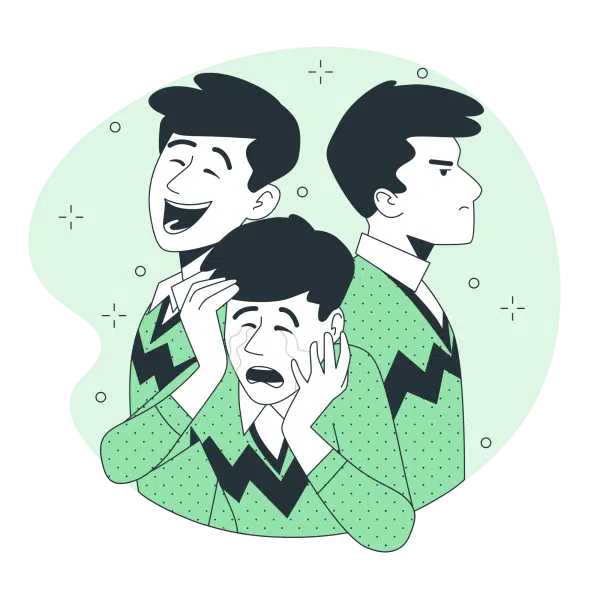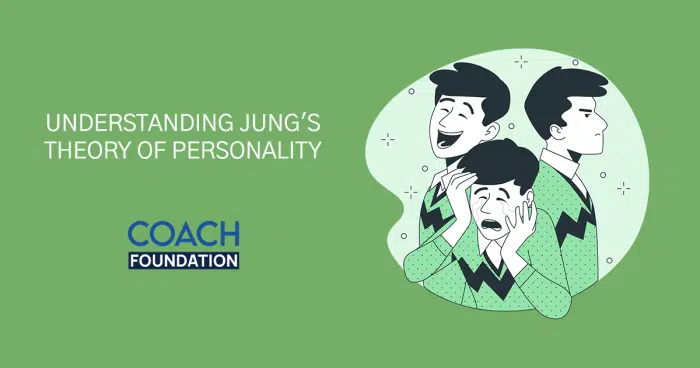Blog » Coaching Models and Techniques » Jung’s Theory of Personality
Jung’s Theory of Personality
Jung’s four personality types may be familiar to you, but what do they actually entail? We’ll thoroughly describe each personality type in this extensive guide and teach you how to determine which one you are.We’ll also go over each type’s advantages and disadvantages and offer you some advice on how to use them. So let’s get going!

In Brief : Jung’s 4 Personality Types
- Extraversion Vs. Introversion – Extraverts are oriented externally, drawing inspiration from the outside world, while introverts focus on their inner world; no direct cost mentioned.
- Sensation Vs. Intuition – Sensing relies on the five senses for information, while intuition involves pattern recognition and deeper meaning; no direct cost mentioned.
- Thinking Vs. Feeling – Thinking types make logical decisions, while feeling types base decisions on personal beliefs; no direct cost mentioned.
- Judging Vs. Perceiving – Judging types value structure and order, perceiving types are more impulsive, and ambiverts combine elements from both; no direct cost mentioned.
The Fundamentals
We’ll be looking at Carl Jung’s four personality types in this article. One of the most well-known and in-depthly researched theories of personality in existence is Jung’s, and his types are still employed in contemporary psychology.
It could be beneficial to first become familiar with some of the fundamental ideas in Jung’s theory if you’re a beginner.
Simply put, according to Jung, every individual has four main psychological processes: sensation, intuition, thinking, and feeling. Additionally, he thought that each person preferred one of these roles over the others.
According to Jung, introverts, extroverts, thinking types, and feeling types entail the four different personality types.
Later on in the article, we’ll talk more specifically about each of these types. But first, let’s look at the history of how these four personality categories that Jung distinguished right now.
History
Carl Jung was carrying on a long-standing historical trend of classifying human temperament and personality. His acknowledged sources of inspiration include:
- Eastern astrologers used the zodiacal signs of the earth, air, fire, and water to categorize humans. A circle with a cross in the center and opposites was used to represent this system.
- The idea that character was determined by the balance of body fluids—considered as two pairs of opposites, phlegm and blood, choler and bile—was first put out by Hippocrates in ancient Greece.
- Thinking, feeling (which was considered to be inferior), and sensation were the three sorts that Gnostic Philosophers recognised, correlating to three of Jung’s psychological functions.
- German poet and philosopher Schiller described a nucleus (such as poetry) that may be divided into its opposites in the eighteenth century.
For instance, two types of poetry could be distinguished: sentimental poetry, which is intuitive and characterized by the poet’s meditation on an inner impression of the object, and naive poetry, which is dominated by feelings and in which the poet is drawn into the object. Naivety and extraversion, as well as sentimentality and introversion, were seen as being compatible by Jung.
- Jung proposed the diametrically opposed attitudinal characteristics of Introversion and Extraversion by drawing on the writings of the philosopher Nietzsche and the psychologist William James.
Nietzsche made a distinction between the Dionysian impulse, which was an unrestrained instinct possessed by savage nature, and the Apollonian impulse, which was introspective and created an interior vision, a state similar to dreaming. The abstract and eternalist rationalist and the fact-based empiricist are two temperaments that James characterized.
He listed opposite quality pairings that defined the two categories. Jung shared this belief in opposites in pairs even though he disagreed with James’ traits.
Jung’s 4 Personality Types
According to Jung’s hypothesis, there are four different personality types: introverts, extroverts, thinking types, and feeling types. Let’s examine each of these concepts in more detail in order to fully understand them.
Jung’s Theory of Personality – Simplest Explanation Ever
Those who are introverts need time alone to refuel. They typically dislike huge crowds and prefer quieter environments.
On the other hand, extraverts get energy from being among others. They are frequently the life of the party and do well in social situations.
Thinking personalities are analytical and unbiased. They make decisions based on justification and reasoning. As their name implies, feeling types base their decisions on their emotions. They frequently prioritize others over themselves.
You can begin to see yourself and others with a new perspective if you have a basic understanding of these four personality types. You can also test your personality type if you wish too!

1. Extraversion vs. introversion
An extrovert is generally oriented by the exterior world, whereas an introvert is generally orientated by the inner world, according to Jung’s definition of the extrovert-introvert divide.
In contrast to introverts, who are more prone to look within for direction and inspiration, extroverts are more motivated by what they observe and experience in the world around them.
This does not imply that one is superior to the other because both have advantages and disadvantages.
Whereas introverts can be quite creative and have a profound awareness of their own moods and emotions, extroverts are frequently great idea generators and see things from a fresh perspective.
It’s crucial to keep in mind that these are generalizations and that there will inevitably be exceptions. It is completely normal if you think that you do not strongly relate to either one of the two categories.
2. Sensation vs. intuition
The two perceiving functions are sensing and intuition. They assist us process the information we gather from the environment around us. It all comes down to using our five senses—sight, smell, touch, taste, and sound—to gather information.
Contrarily, intuition revolves around pattern recognition. It involves seeing past the obvious aspects in order to discern deeper meaning and recognise how various things are connected.
While intuitive types are more inclined to want to pause and think things through before making a decision, sensing types are more likely to believe their gut feeling and follow their initial instincts.
Intuitive types are also more likely to see the world in terms of concepts and ideas while sensing types are more likely to see the world in terms of concrete details and facts.
3. Thinking vs. feeling
Let’s discuss the feeling-thinking spectrum now that we’ve looked at the introverted-extroverted and sensation-intuition division.
Keep in mind that while thinking types make conclusions based on logic, feeling types base them on their personal beliefs.
Both the cognitive and feeling kinds are significant, but because they approach decision-making in different ways, they occasionally butt heads.
A thinking type may frustrate you if you are a feeling type since they come out as emotionless and frigid. And if you’re a thinking type, a feeling type can find you annoying since you come off as unreasonable and impetuous.
It’s crucial to keep in mind that both the thinking and feeling kinds have essential things to offer, and that both are necessary for a balanced society.
4. Judging vs. perceiving
It’s crucial to keep in mind that not everyone will precisely fit into one group or the other. In actuality, the majority of people have a combination of personality types.
Yet, understanding the various sorts will help you better understand both yourself and other people.
Considering the judging-perceiving spectrum is one way to think about different personality types. Those who value structure and order are at one end of the spectrum (judging type).
Conversely, other people are more impulsive and like to go with the flow (perceiving type). Then, in the middle, are people who combine elements from both groups (also known as the ambivert).
After understanding a bit more about these 4 spectrums, I am sure you will be curious to understand your own Jungian Personality which you can try for free throughout by taking the Jung Typology Test.
Conclusion
Introverted intuition, extroverted intuition, introverted sensation, and extroverted sensation are Jung’s four personality types. Each kind has a unique perspective on the world and method of processing information.
You can better understand yourself and others by having a better understanding of Jung’s personality types.
It can also assist you in developing coping skills for dealing with difficult people and better understanding your relationships.
Frequently Asked Questions (FAQs)
How do I know my Jungian type?
There are various free online quizzes which analyze your Jungian personality type, one of which can be found here.
What is the rarest Jung personality type?
INFJ is the rarest personality type across the population, occuring in just 2% of the population. It is also the personality type that male population has the least of. Introversion, Intuition, Feeling, and Judging is referred to as INFJ.
What is the most loved personality type?
ESFJ. People who fit the ESFJ personality type can usually be recognized by their big hearts and kindly manner. ESFJs are warm and welcoming and their love of tradition means they value good old-fashioned manners highly.

